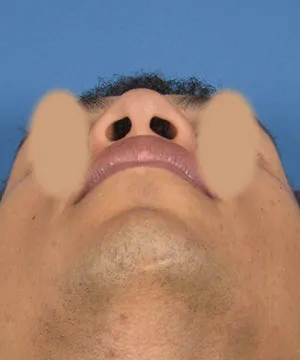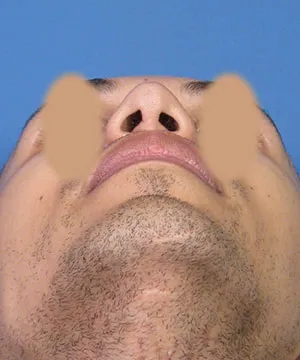This is a great example of what cosmetic nose reshaping can do in the African American rhinoplasty patient. This particular African American male presented to my office desiring to have his nose reshaped. He was unhappy with the fact he had a bump on the nose (also referred to by many patients as a ‘hump’ deformity) as seen from the side view and the bridge was too wide as seen from the front view. In addition, he had somewhat poor tip definition due to a more rounded shape and a broad, wide nostril base.
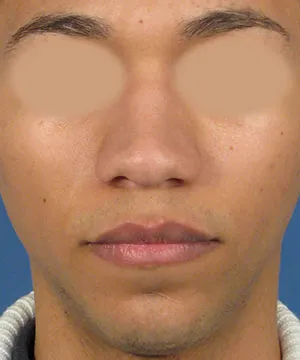
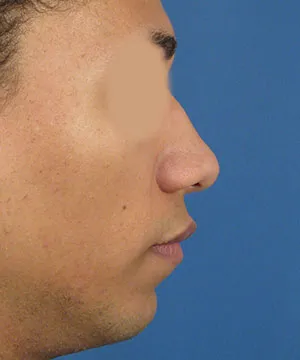
Typical African American Nose Features
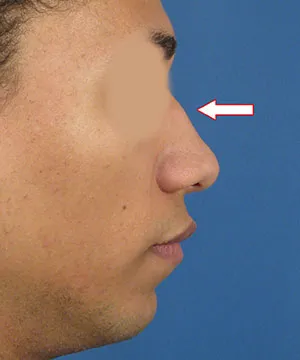
All in all, these features are seen quite commonly in the African American nose and are a frequent source for those seeking cosmetic ethnic rhinoplasty surgery. African American noses often times have a nasal bridge that is too low, but, as in this case example, some African American rhinoplasty patients actually have a bump on the bridge. This is noted in the adjacent photo diagram as indicated by the white arrow, which shows the dorsal hump deformity on his profile view. What the dorsal hump deformity usually does is disrupt what would otherwise be a straight nasal profile while drawing unwanted attention to this area.
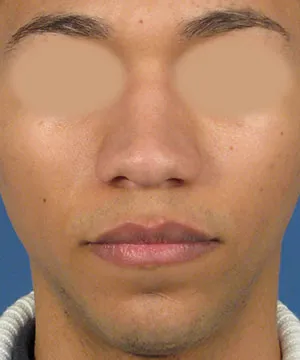
This finding is seen commonly seen in conjunction with a bridge that looks too wide from the front view. This is because the African American patient usually has a short nasal bone that does not allow the bridge to project very far out from the plane of the face. In addition the nasal bone comes off of the face in a more lateral (toward the side of the head) location. Consequently, the bony portion of the nasal bridge gives the nose the appearance of being too wide, or broad, when seen from the front.
The lack of tip definition in this African American rhinoplasty patient is directly related to the underlying anatomy. In the average African American nose, the tip skin is quite thick and the underlying cartilage is fairly weak. This is a setup for poor tip definition since the thick ethnic skin tends to easily ‘hide’ the underlying cartilage, which is the one thing that gives the nasal tip its shape. As seen in the adjacent photograph, this African American patient’s nasal tip is moderately rounded with a relative lack of definition.
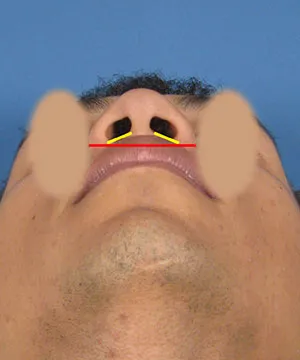
With regard to his broad, wide nostril base – this is also frequently seen in the African American rhinoplasty candidate. In many cases, not only is the actual width of the base (as measured from the outer margin of one nostril to the outer margin of the opposite side) excessive, the width of the nostril opening (referring to the sill region) is also too wide. In the adjacent photo diagram, the overall nasal width is indicated by the red line that spans the distance from the outer margin of one nostril to the outer margin of the other. We often times refer to this portion of the nostril base as being excessively ‘flared’ when we describe it being too wide. This is because the thick skin in this region curves outward, or flares, to the side of the nose. The more flaring that is present, the wider the nasal base appears. But one must also pay attention to the sill region as indicated by the yellow line. This segment corresponds to the actual width of the nostril opening, which is commonly excessive in the African American nose and has to be acknowledged in conjunction with the wide, flared nostril base, if present.
African American Rhinoplasty
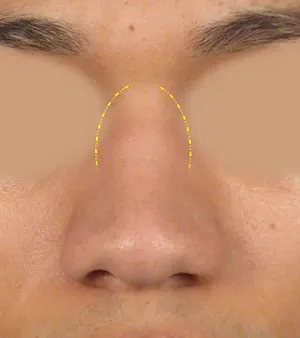
In this particular case, I recommended an open rhinoplasty approach for the cosmetic reshaping process. The open approach in the African American rhinoplasty patient provides significant advantages in terms of surgical exposure and ability to more accurately reshape the nose.
Using this open rhinoplasty approach, his nasal bridge was rasped, or sanded, down to try and reduce the prominence of the hump deformity. Once the bump was addressed, attention was then turned to the nasal bones. As shown in the adjacent photo diagram, I actually had to cut his nasal bone on each side. This corresponds to the dashed yellow line in the photo where an instrument called an osteotome was used on the inside of the nose under the skin to cut the bone. Once the bone is cut on both sides, it can then be moved inward to narrow the bridge. Many African American rhinoplasty patients and surgeons refer to this maneuver as ‘breaking the nasal bones’ when it is performed. In essence, that is what is being done, but with a very precise technique to create as much symmetry in the nose as possible. If you look closely, though, you will see that these osteotomies to ‘break the nasal bones’ only really narrow the upper one third to one half of the nose. As a result, something else has to be done to the lower one half of the nose – the tip, in particular – to narrow the remainder as desired.
In this particular African American rhinoplasty case example, the tip was narrowed using a number of maneuvers. This is actually more the rule than the exception when it comes to ethnic rhinoplasty cases like African American noses – a sequence of surgical steps is necessary to achieve the desired change in tip shape. In this instance, the nasal tip was defined using a combination of cartilage reshaping and conservative thinning of the overlying soft tissue. This latter maneuver was necessary in order to make the skin thinner so that it would more readily show the type of changes being made to the cartilage.
The wide nasal base was addressed by using a combination of wedge and sill excisions. This involved removing some of the thicker, flared soft tissue around the base (bottom) of the nose while also removing some skin from inside of the actual nostril opening.
African American Rhinoplasty Results
Shown below are the results of this particular patient’s African American rhinoplasty procedure.
Frontal Before and After
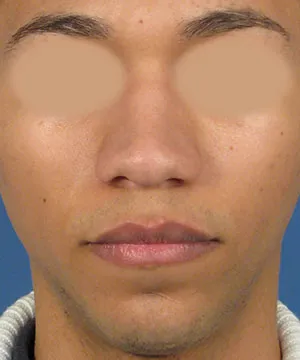
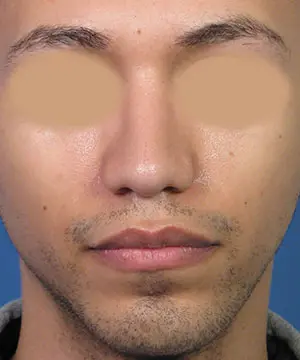
As you can see from the before and after frontal photos, he now has a more refined looking nose that, in general, appears more narrow. It certainly does not look too thin for his surrounding facial features. It just shadows better when seen from the frontal view and is not as broad as it used to be in terms of the nasal tip and base. Most importantly, his nose still appears ethnic as it should for any African American rhinoplasty patient. Keep in mind the goal in ethnic rhinoplasty is to reshape the nose such that certain undesirable features are minimized – but maintenance of an ethnic appearing face (and nose) is vital to achieving natural looking results.
Oblique Before and After
The oblique before and after photos also visually demonstrate how the nose now looks smaller from an angled view. As you can see in his before surgery photo, the nasal base is quite rounded and flared – contributing to the appearance that his nose is just wide at the bottom. This is one of the more common issues encountered in African American rhinoplasty. Following surgery, though, you can tell this portion of the nose has been reshaped to look more narrow.
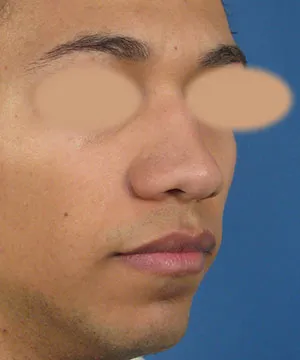
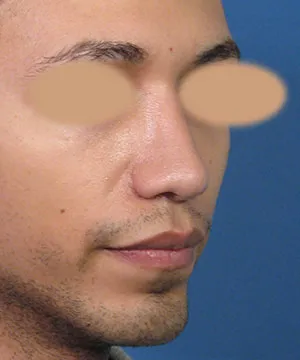
Lateral Before and After
On the lateral before and after photos, you can see that the bridge has been reshaped to appear straighter on his profile view. This gives the illusion the nose is smaller and now more refined.
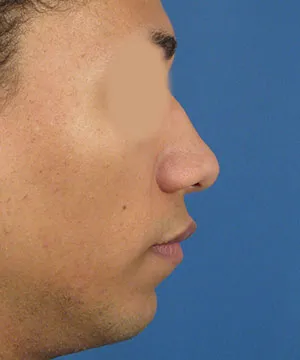
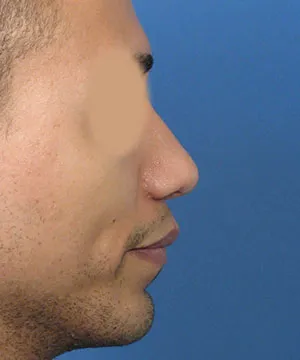
Base Before and After
On the base view of the nose, you can appreciate even more so how the bottom of the nose has been narrowed. More specifically, you can see how the wedge and sill excisions made around the base of the nose create a less flared appearance. In combination with the tip reshaping, the overall appearance of his nasal base is now more triangular and defined.
